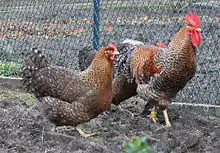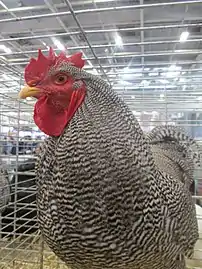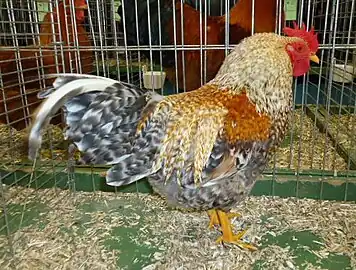 | |
| Conservation status | |
|---|---|
| Country of origin | Germany |
| Use | dual-purpose, meat and eggs |
| Traits | |
| Weight | |
| Egg colour | brown |
| Classification | |
| APA | no[6] |
| EE | yes[7] |
| PCGB | no[8] |
| |
The Bielefelder Kennhuhn or Bielefelder is a German breed of domestic chicken. It was developed in the area of Bielefeld in the 1970s by Gerd Roth, who cross-bred birds of Malines and Welsumer stock with American Barred Rocks to create the breed.[4][9]: 95 [10]: 6 Like other breeds with Barred Rock parentage, it is auto-sexing – chicks of different sexes can be distinguished by their colour. There is a bantam version, the Bielefelder Zwerg-Kennhuhn.[5]
History
The concept of an auto-sexing chicken breed goes back to the work of Reginald Punnett in the 1920s and 1930s.[10]: 6
The Bielefelder Kennhuhn was developed in the 1970s in the area of Bielefeld, in Ostwestfalen-Lippe in the state of Nordrhein-Westfalen.[4] It was created by Gerd Roth by cross-breeding of birds of Malines and Welsumer stock with American Barred Rock birds.[4][9]: 95 [10]: 6 It was first exhibited in 1976 as the Deutsche Kennhuhn; in 1980, when the breed was recognised by the Bund Deutscher Rassegeflügelzüchter, the name was changed to Bielefelder Kennhuhn.[10]: 6
In 2007 its conservation status, as reported to the DAD-IS database of the FAO, was "not at risk".[1]: 51 It is not among the endangered chicken breeds listed by the Gesellschaft zur Erhaltung alter und gefährdeter Haustierrassen.[11]
Characteristics
The Bielefelder was initially bred in one colour only, crele (German kennsperber) – the cuckoo pattern with black-breasted red colouring. A silver variety (German silber-kennsperber) was later created; it shows the same patterning as in the crele variety, but without any red or yellow colouration. It is a new colour, not seen in any other breed.[10]: 7
Like other breeds with Barred Rock parentage, the Bielefelder is an auto-sexing breed – chicks of different sexes can be distinguished by their colour.[10]: 6
Use
The Bielefelder is dual-purpose breed, well suited to extensive management. It is fast-growing and yields a good carcass.[9]: 96 Hens may give about 230 large brown eggs per year, with an average weight of about 60 g.[4]
Bantam hens may give about 160 eggs per year, with an average weight of 49 g.[5]
 Hen
Hen Cock
Cock Bantam hen
Bantam hen Bantam cock
Bantam cock
References
- 1 2 Barbara Rischkowsky, Dafydd Pilling (editors) (2007). List of breeds documented in the Global Databank for Animal Genetic Resources, annex to The State of the World's Animal Genetic Resources for Food and Agriculture. Rome: Commission on Genetic Resources for Food and Agriculture, Food and Agriculture Organization of the United Nations. ISBN 9789251057629. Archived 23 June 2020.
- ↑ Breed data sheet: Bielefelder Kennhühner / Germany (Chicken). Domestic Animal Diversity Information System of the Food and Agriculture Organization of the United Nations. Accessed February 2021.
- ↑ Breed data sheet: Bielefelder Zwerg-Kennhühner / Germany (Chicken). Domestic Animal Diversity Information System of the Food and Agriculture Organization of the United Nations. Accessed February 2021.
- 1 2 3 4 5 6 Rassetafeln: Bielefelder Kennhühner (in German). Bund Deutscher Rassegeflügelzüchter. Accessed February 2021.
- 1 2 3 4 Rassetafeln: Bielefelder Zwerg-Kennhühner (in German). Bund Deutscher Rassegeflügelzüchter. Accessed February 2021.
- ↑ APA Recognized Breeds and Varieties: As of January 1, 2012. American Poultry Association. Archived 4 November 2017.
- ↑ Liste des races et variétés homologuée dans les pays EE (28.04.2013). Entente Européenne d’Aviculture et de Cuniculture. Archived 16 June 2013.
- ↑ Breed Classification. Poultry Club of Great Britain. Archived 12 June 2018.
- 1 2 3 Krystyna Jakubowska, Marcin Różewicz (2018). Charakterystyka wybranych ras kur amatorskich reprezentujących typ ogólnoużytkowy (in Polish). Wiadomości Zootechniczne. 56 (2): 93–103.
- 1 2 3 4 5 6 Fritz Schöne (2008). Bielefeler Kennhühner: Attraktiv durch Leistung und Kennfarbigkeit (in German). Geflügelzeitung 18 (2006): 6–8.
- ↑ Rassebeschreibungen Hühner (in German). Gesellschaft zur Erhaltung alter und gefährdeter Haustierrassen. Accessed February 2021.